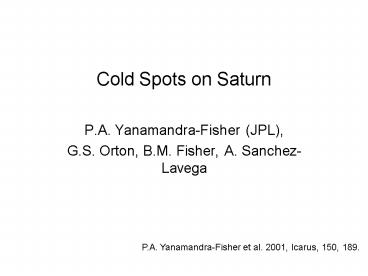Cold Spots on Saturn - PowerPoint PPT Presentation
Title:
Cold Spots on Saturn
Description:
Saturn on the other hand has a larger contribution from reflected ... The spectrum of Saturn at 5 microns shows that at 5.2 microns ... of Saturn. ... – PowerPoint PPT presentation
Number of Views:82
Avg rating:3.0/5.0
Title: Cold Spots on Saturn
1
Cold Spots on Saturn
- P.A. Yanamandra-Fisher (JPL),
- G.S. Orton, B.M. Fisher, A. Sanchez-Lavega
P.A. Yanamandra-Fisher et al. 2001, Icarus, 150,
189.
2
The 5 micron region is an atmosphere window that
is relatively free of gaseous absorption on
Earth, Jupiter, and Saturn. In the case of
Jupiter this allows the deep atmosphere to be
probe. Openings in the clouds appear as hot
spots in the atmosphere of Jupiter where heat
from the deep atmosphere of Jupiter can be
observed. Saturn on the other hand has a larger
contribution from reflected sunlight at 5
microns. To minimize the reflected light
component, images were made of Saturn at 5.2
microns using a narrow-band filter in NSFCAM.
These images, shown in the next slide, show
unexpected dark spots that are colder than the
surrounding areas by up to 10 K.
3
Images of Saturn at 5.2 microns taken with NSFCAM.
4
The spectrum of Saturn at 5 microns shows that at
5.2 microns there is much less absorption from
phosphine (PH3). Thus it is possible to see
deeper into the atmosphere at 5.2 microns.
Simple modeling indicates that variations in a
cloud layer at about 1.5 bar can explain the
observations. The cold spots are interpreted as
being regions of higher opacity at the 1.5 bar
level. The implications of this discovery is that
the 5.2 micron region is a place where cloud
dynamics at the 1.5 bar level can be studied.
This will provide a fruitful spectral region to
study with the Visible/Near Infrared Mapping
Spectrometer (VIMS) on Cassini.
5
5 micron spectrum of Saturn. PH3 absorbs
strongly at 4.55-5.0 microns and NH3 at 5.25-5.4
microns. The filter bandpass at 5.2 micron is
shown by the triangular dashed curve.































